Metacognition
How Helping Students to Ask Better Questions Can Transform Classrooms. To get started with the QFT, first give students time to develop as many questions as they can, with the instruction not to worry if it’s a “good or bad” question. The only requirement is that they be questions, not statements. After the initial fast brainstorm, talk about the difference between closed and open questions, discussing the advantages and disadvantages of both. Then ask students to categorize their questions as “open” or “closed.”
The next step is to ask students to change some of their questions from open to closed and vice versa. “It’s in the working with the questions that something happens,” said Rothstein, co-director of The Right Question Institute, during a session at the Building Learning Communities conference. After working with questions they developed in this way, ask students to pick their best three questions.
The Critical Thinking Skills Cheatsheet [Infographic]
Critical thinking skills truly matter in learning.
![The Critical Thinking Skills Cheatsheet [Infographic]](http://cdn.pearltrees.com/s/pic/th/critical-thinking-cheatsheet-143956726)
Why? Because they are life skills we use every day of our lives. Everything from our work to our recreational pursuits, and all that’s in between, employs these unique and valuable abilities. Consciously developing them takes thought-provoking discussion and equally thought-provoking questions to get it going. Begin right here with the Critical Thinking Skills Cheatsheet. It’s a simple infographic offering questions that work to develop critical thinking on any given topic.
The Questioning Toolkit - Revised. The first version of the Questioning Toolkit was published in November of 1997.

Since then there has been substantial revision of its major question types and how they may function as an interwoven system. This article takes the model quite a few steps further, explaining more about each type of question and how it might support the overall investigative process in combination with the other types. photo ©istockphoto.com Section One - Orchestration Most complicated issues and challenges require the researcher to apply quite a few different types of questions when building an answer. Orchestration is the key concept added to the model since its first version.
To Boost Higher-Order Thinking, Try Curation.
33 Lessons on Critical Thinking. 30 Universal Strategies For Learning. 30 Universal Strategies For Learning by Terry Heick As teachers, we’re all trying to better understand how people learn–not now they’re taught in terms of teaching strategies, but more so learning strategies–only not really strategies.

Learning actions, or cognitive actions.
How to Think Visually. How to Think Visually Using Visual Analogies infographic from Anna Vital gives a great variety of examples for anyone to use when you create your own graphics.
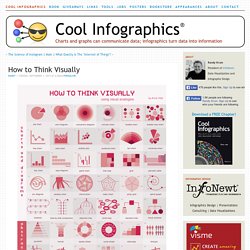
It begins with the most recognizable visuals, circle graphs and diagrams. Further down are abstract analogies. They are reminiscent of physical objects, but they are simplified and abstract. Next, we have regular analogies that look like the physical objects you are familiar with. The final category are allegories.
Visual note taking is back and it has a cool history. You may have seen them at the last conference or big corporate meeting you attended: beautifully hand drawn notes that summarize big ideas using simple visuals.

This Web 3.0 generation has adopted the term "sketchnotes" which was coined by interface designer, illustrator, and author . The field is actually called Graphic Recording which is "capturing everyone’s most salient points and making them stick", . Practitioners call themselves all sorts of things, Sketchnote Artists, Visual Note Takers, Graphic Recorders, Scribes, Visual Notes Artists, Live Sketch Artists, Group Graphics Practitioners and more.
Brain Labs: A Place to Enliven Learning. Although emotion and cognition originate in different parts of the brain, they interact and play a powerful role in learning and memory.
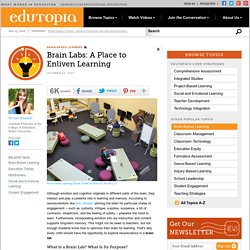
According to neuroscientists like Eric Jensen, priming the brain for particular states of engagement -- such as curiosity, intrigue, surprise, suspense, a bit of confusion, skepticism, and the feeling of safety -- prepares the mind to learn. Furthermore, incorporating emotion into our instruction and content supports long-term memory. This might not be news to teachers, but not enough students know how to optimize their brain for learning.
That's why every child should have the opportunity to explore neuroscience in a brain lab. What Is a Brain Lab? Every school or classroom should have a student- and teacher-created brain lab with these goals: Students could be assigned personal folders with choices of lab activities. Using Pop Culture to Study the Brain Some brain-related topics could take advantage of recent research and pop culture.
10 Ways to Improve Student Brainstorming. The questions that matter most — The Learner's Way. As teachers we face numerous challenges as we manage our duties and strive to provide our students with the best opportunities to learn and realise their potential within a safe and supportive environment.
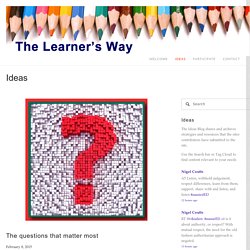
We develop philosophies of learning, vision and mission statements; we plan programmes of learning, engage with professional development, communicate with parents and community members and through reflection and assessment refine our processes.
Documenting the transformation of my classroom into a 21st Century place for learning. Make sure you make it to the end of this post to see the rubrics students create.
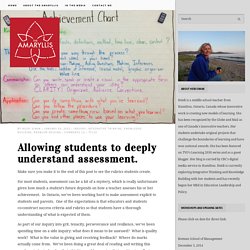
For most students, assessment can be a bit of a mystery, which is really unfortunate given how much a student’s future depends on how a teacher assesses his or her achievement.
Visual thinking. Visual thinking is a way to organize your thoughts and improve your ability to think and communicate.

It’s a way to expand your range and capacity by going beyond the linear world of the written word, list and spreadsheet, and entering the non-linear world of complex spacial relationships, networks, maps and diagrams. It’s also about using tools — like pen and paper, index cards and software tools — to externalize your internal thinking processes, making them more clear, explicit and actionable. Why is visual thinking important?
The Learning Spy - Hexagonal Learning. The Question Game: A Playful Way To Teach Critical Thinking. The Question Game by Sophie Wrobel, geist.avesophos.de The Question Game: A Playful Way To Teach Critical Thinking Big idea: Teaching kids to ask smart questions on their own.
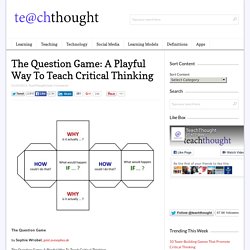
Critical Digital Literacy Explained for Teachers. 13 Strategies to Improve Student Classroom Discussions. Samantha Cleaver Leo Tolstoy's The Two Brothers tells the story of two brothers who are offered the opportunity to find happiness. One chooses to go on a journey and finds happiness—as well as difficulties—along the way, while the other stays at home and leads a happy but uneventful life. When Jasmine Williams' fifth-grade students at Carter School of Excellence in Chicago read The Two Brothers, they discussed this question: Which brother made the better choice?
The Lab. Visible Thinking.

![The Critical Thinking Skills Cheatsheet [Infographic]](http://cdn.pearltrees.com/s/pic/th/critical-thinking-cheatsheet-143956726)








